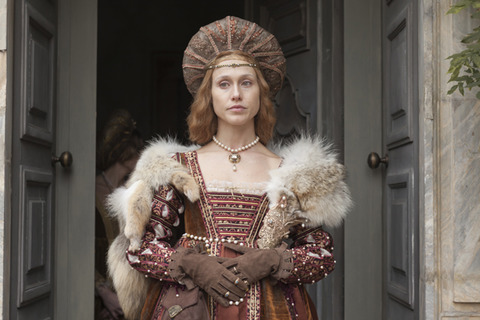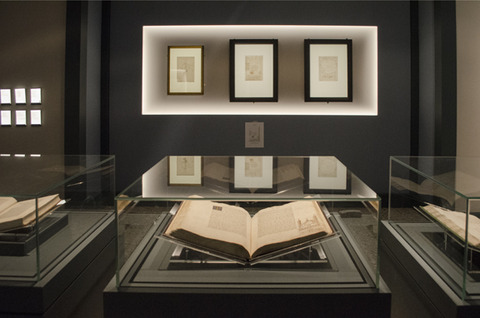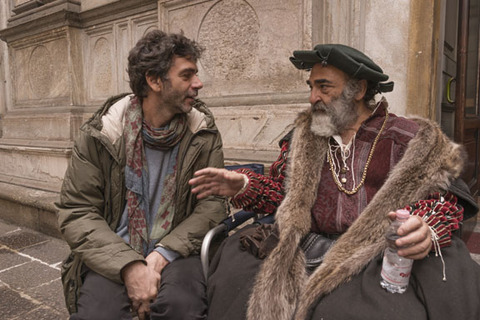Leonardo da Vinci–The Genius in Milan: The Marketing of Genius
REVIEWS, 26 Sep 2016
Lee Parsons | WSWS – TRANSCEND Media Service
Directed by Luca Lucini and Nico Malaspina; screenplay by Jacopo Ghilardoti and Gabriele Scotti
23 Sep 2016 – Screened in Toronto this past summer, Leonardo da Vinci–The Genius in Milan is being distributed in over 50 countries this year and comes out of the largest exhibition ever mounted in Italy of the work of the great polymath, Leonardo da Vinci (1452-1519). The latter took place in Milan in the spring of 2015 and was itself the product of collaboration among some of the leading scholars and experts in Europe.
The film, directed by Luca Lucini and Nico Malaspina, focuses on the 16 years, from 1482 until 1499, that Leonardo spent in what was then the city-state of Milan.
Given the enormous richness of this period in the artist’s life, merely shining a light on his legacy may be a worthwhile accomplishment. Unfortunately, certain regrettable creative choices (which appear to have been made only to reach the widest possible audience) and the tawdry marketing and crafting of The Genius in Milan contrast sharply with the exceptional achievements of its subject and many of its participants.
The weaknesses of this production, billed as an “exhibition event,” are apparent from the outset. Its opening feels like a promotional ad, which means to generate gravitas and drama but comes across too polished and packaged to be taken seriously. We see a reenactment of the careful packing and shipping of one of Leonardo’s greatest works, La Belle Ferronnière (1490-96) as it is removed with solemnity and reverence from its home in the Louvre in Paris and flown to Milan for EXPO 2015. The exaggerated tone permeates the film and only helps undermine the respect that the filmmakers are clearly trying to inspire.
Unhappily, one cringes as this production’s crass approach becomes apparent. Seductive camera work, impressive visual effects and other costly production values indicate a healthy budget. That same budget also allows for excesses and gimmicks that continue throughout the film and nearly eclipse a subject matter the producers apparently don’t trust to otherwise hold the viewer’s interest.
The high definition photography of some of the artist’s most enduring paintings is nevertheless captivating on the big screen—these include the Mona Lisa (La Gioconda, c. 1503-06) and La Belle Ferronnière (also known as Portrait of an Unknown Woman. The film employs 4K photography, an advance in ultra-high definition digital video allowing us to see a number of the artist’s works with a degree of detail that approaches an in-person viewing.
The other principal merit of Leonardo da Vinci–The Genius in Milan lies in a number of the on-camera interviews. The figures interviewed include renowned experts such as Claudio Giorgione, from the National Museum of Science and Technology in Milan, who speaks on the profound contribution Leonardo made to many scientific fields. There is further valuable commentary by Richard Schofield on his architectural work.
Leonardo in Milan
The economic and social changes associated with the rise of the Renaissance (from the 14th to the 17th centuries) allowed for the flourishing of a more fully developed and all-rounded human being. A new social type emerged, since known as the “Renaissance man,” of which Leonardo da Vinci is perhaps the classic example.
The illegitimate son of an affluent Florentine notary, Leonardo was not accepted into his father’s family until late in childhood. He was nevertheless given the benefit of a proper education and, having shown unusual talent early on, was eventually placed as an apprentice to a prominent local artist. He did not make a real name for himself until well along in his career, and his reputation was hampered by his habit of not finishing commissions and projects, often disappearing without notice. This was more a matter of an insatiable curiosity than anything else, which drove Leonardo from one pursuit or investigation to another in a lifelong fury of creative output.
Along the same lines as the 2015 exhibition, The Genius in Milan is arranged in twelve sections, tracing the complex course that Leonardo followed after he left Florence and began his work in Milan. The film does not follow his time there in a strict chronological order. Leonardo’s difficulty in completing projects presented problems for him in winning new commissions, although he did have devoted patrons, including the powerful Duke of Milan, Ludovico Sforza, who commissioned The Last Supper (1495-98). That famed mural has undergone numerous efforts at restoration and was the subject of a high-definition video also made for the 2015 show.
In Milan Leonardo also produced most of the 1,100 drawings and writings that were later collected, in 12 volumes, in what is known as the Atlantic Codex.
Despite Leonardo’s voluminous writing on many subjects, including philosophy, art and technology, details about his personal life remain fairly sketchy and this is particularly true of his early years. This dearth of documentation has allowed for a good deal of speculation about his life and the Lucini–Malaspina documentary indulges in imaginings along these lines as well.
Unhappily, aside from the repeated observation that Leonardo did not view himself principally as a painter, the film does not offer a cohesive theme or guiding perspective as we move from one disjointed segment to the next. The documentary touches on Leonardo’s varied investigations and inventions. We also learn details about the conditions under which Leonardo worked in the Sforza court and some of the painters who were influenced by him. Co-curators of the 2015 exhibition Pietro Marani and Maria Teresa Fiorio offer some commentary on aspects of the artist’s life and work.
The efforts to re-enact episodes in Leonardo’s life constitute the most awkward portions of The Genius in Milan. Although performed competently by some talented actors, including Cristiana Capotondi, Alessandro Haber, Gabriella Pession and Nicola Nocell, these segments—delivered directly to the camera in the manner of an aside in Shakespeare—are conceived of in the manner of petty, personal gossip that does no credit to the subjects or participants.
The general effect of the invented—and undignified—scenes and dialogue is to lower the overall quality of the film and hamper a serious consideration of the artist and the period.
The authentic settings used in these dramatizations, such as the Bicocca degli Arcimboldi (a 15th century villa) and the Basilica of Santa Maria delle Grazie, are beautifully filmed if only as the backdrop to the unfortunate skits. The tone of the film alternates between the undignified one created by these imagined forays into Leonardo’s personal life and a grave reverence for the artist, which is also extreme. In either case, little of substance is revealed about Leonardo the man or the transformative period that produced such a figure.
Genius and history
It is inspiring to reflect on the extraordinary human capability and potential embodied in the figure of Leonardo da Vinci. Our confidence in humanity in general has to be fortified by such a reflection, especially in a period of cultural crisis like the present one where many, including “left” intellectuals, have come to question the very idea of human progress.
What might be more helpful in a film like The Genius in Milan is some effort to understand the relationship between such advanced individuals and the broader historical and social processes they reflect.
Frederick Engels associated the Renaissance with “that mighty epoch when feudalism was smashed by the burghers [urban bourgeoisie]. … It was the epoch which brought into being the great monarchies in Europe, broke the spiritual dictatorship of the Pope, evoked the revival of Greek antiquity and with it the highest artistic development of the new age, broke through the boundaries of the old world, and for the first time really discovered the world.”
In explaining why the Italian Renaissance was so culturally rich, Leon Trotsky noted that “the Renaissance only begins when the new social class [the bourgeoisie], already culturally satiated, feels itself strong enough to come out from under the yoke of the Gothic arch [i.e., feudal culture], to look at Gothic art and on all that preceded it as material for its own disposal, and to use the technique of the past for its own artistic aims.”
The upheaval in social relations allowed for greater independence for artists and artisans who were now able to offer their services more freely to a growing variety of patrons. Geographic boundaries loosened as well, lessening the grip of the dominant city-states of Florence, Venice and Milan on culture and trade, and allowing the leading artists and craftsmen of the day, including Leonardo, to compete in an expanding market for lucrative commissions and recognition right across Europe.
In the course of The Genius in Milan we hear from experts on Leonardo who enthusiastically expound on the wonders and mystery surrounding this man, but the perspective advanced is generally limited to his personal achievements and dealings largely disconnected from the social forces that produced him. In this regard, it should be emphasized that while Leonardo may have been the most outstanding figure, he was just one of many brilliant artists, writers, thinkers and explorers of the period who represented a broad advance in human progress.
We are speaking of the birth of the modern world, at a time when capitalism was at its most revolutionary and progressive. Some insight ought to be offered into this process by a film dedicated to one of the most brilliant lights of this era.
DISCLAIMER: The statements, views and opinions expressed in pieces republished here are solely those of the authors and do not necessarily represent those of TMS. In accordance with title 17 U.S.C. section 107, this material is distributed without profit to those who have expressed a prior interest in receiving the included information for research and educational purposes. TMS has no affiliation whatsoever with the originator of this article nor is TMS endorsed or sponsored by the originator. “GO TO ORIGINAL” links are provided as a convenience to our readers and allow for verification of authenticity. However, as originating pages are often updated by their originating host sites, the versions posted may not match the versions our readers view when clicking the “GO TO ORIGINAL” links. This site contains copyrighted material the use of which has not always been specifically authorized by the copyright owner. We are making such material available in our efforts to advance understanding of environmental, political, human rights, economic, democracy, scientific, and social justice issues, etc. We believe this constitutes a ‘fair use’ of any such copyrighted material as provided for in section 107 of the US Copyright Law. In accordance with Title 17 U.S.C. Section 107, the material on this site is distributed without profit to those who have expressed a prior interest in receiving the included information for research and educational purposes. For more information go to: http://www.law.cornell.edu/uscode/17/107.shtml. If you wish to use copyrighted material from this site for purposes of your own that go beyond ‘fair use’, you must obtain permission from the copyright owner.


